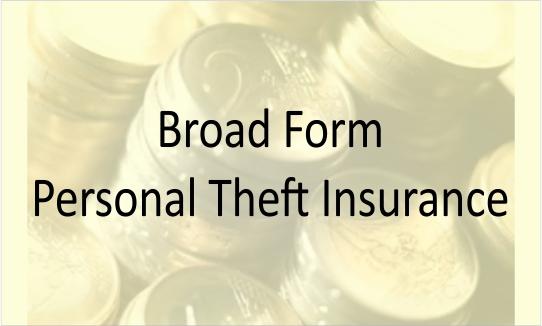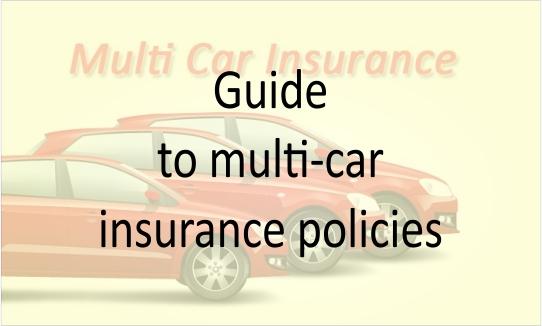Broad Form Personal Theft Insurance

Broad Form Personal Theft Insurance covers the theft or loss of personal assets.
DEFINITION of Broad Form Personal Theft Insurance
Broad frorm personal theft insurance covers the theft or loss of personal assets. It can be placed on all personal property, and is on an all-risk basis meaning no matter whether the loss is from vandalism, theft or loss, the same coverage will apply. A limited form of broad form insurance is more commonly known as personal theft insurance.
BREAKING DOWN Broad Form Personal Theft Insurance
There are limitations on the coverage of personal assets which are most often subject to theft such as jewelry, coins and securities, among others. Personal assets insurance is commonly included in homeowners and auto insurance, however, additional insurance may be purchased.
How Personal Theft Insurance Works
This type of coverage is standard on homeowners and renter policies. The limitations and exclusions built into standard policies, however, makes this coverage not very comprehensive and of little use if something really valuable is lost or stolen.
Consider this boilerplate from a standard homeowners policy that's in wide use: We do not pay for: a. theft by an insured person; b. theft in or to a structure being built, or theft of materials and supplies for use in construction of the structure, until the structure is finished and occupied; c. loss of a precious or semiprecious stone from its setting; d. loss that results from the theft of a “credit card”; or e. theft from a part of the dwelling usually occupied solely by an insured person while it is rented to others.
There are money limits on all claims: $200 on money, bank notes, bullion, gold other than goldware and gold-plated ware, silver other than silverware and silver-plated ware, platinum, coins, and numismatic property. b. Regardless of their storage medium, $1,000 on securities, bills, letters of credit, notes other than bank notes, tickets, accounts, deeds, evidence of debt, passports, manuscripts, stamps, and philatelic property. c. $1,500 on jewelry, watches, precious and semiprecious stones, gems, and furs. d. $2,500 on silverware, goldware, pewterware, and items plated with gold or silver. e. $2,000 on guns and items related to guns. f. “Business” property, up to the amounts shown below: 1) $2,500 while on the “insured premises”; 2) $250 while away from the “insured premises”. g. $1,000 on watercraft including their trailers, furnishings, equipment and motors. h. $1,000 on trailers not otherwise provided for.
The point here is if you have valuables you want covered by insurance, you'll need to purchase a rider. Riders can add up to 20% to your annual premiums, but you'll get full coverage of items such as jewelry, coins and artworks. Many people find it cheaper to skip the riders and lease a safety-deposit box instead for smaller items.
Car insurance for young drivers - the key facts
Young drivers’ car insurance is likely to be very expensive and as a new driver it’s good to know about different coverage levels and what affects how much you pay. Here you can find out everything you need to know about new driver car insurance, how to get the best deal and reduce your premiums. Young driver insurance tips So you’ve passed your test, you’ve chosen a car, and now all you need is insurance! If you’re driving without car insurance then you’re breaking the law. You could have your vehicle confiscated, be issued a penalty fine, and have to pay to have your car released. What’s more, if you’re uninsured and have an accident, you’ll be liable for the cost of everyone else’s injuries, their damages, compensation and repairs, even if the accident wasn’t your fault. You will lose your licence and may lose your job because of this. So whilst your car insurance may seem expensive to begin with, it’s nothing…
Guide to multi-car insurance policies
One of the easiest ways to save on car insurance is to insure more than one car on the same policy. When you get married, for example, you’ll save because married drivers tend to file fewer claims and thus get lower rates. A good driver discount requires a clean record. But a multi-car discount doesn’t require a lifelong commitment or scrupulous attention to speed-limit signs. Instead, it’s a reward for bringing your insurance company additional business. What are the requirements for a multi-car policy? Does the coverage need to be the same on each vehicle? Can I insure a car and a motorcycle on the same policy? What are the benefits of a multi-car policy? How big is a multi-car discount? Can I add other family members’ cars to my policy? What are the requirements for a multi-car policy? To obtain a multiple-car policy…
Saving on Insurance: Home and Auto Insurance Bundling
Bundling your auto and auto insurance policies under the same company is a convenient way to save hundreds on your insurance. More than half of Americans bundle their auto and home insurance. Those who aren't doing so are handing over more money to their insurers. Bundling your policies aren't always the best choice. You may get lower rates by buying separate policies from multiple companies, but it's a good idea to get a quote if you were to bundle policies. To find out if bundling is right for you, compare car insurance rates with and without bundling. What is bundling? Most insurance companies offer bundling discounts, which just means getting two policies from…


